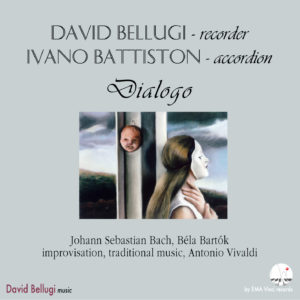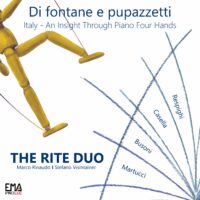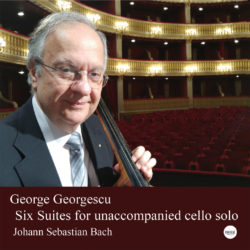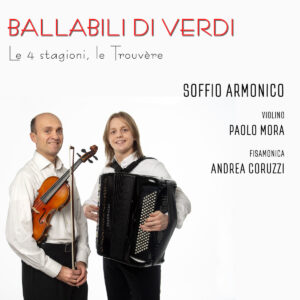Descrizione
-
Sonata in Fa Maggiore Op 17 Ludwig Van Beethoven
-
Intermezzo Op. 35 N°11 Reinhold Glière
-
3 Romanze per oboe e pianoforte op.94 (N°1) Robert Schumann
-
3 Romanze per oboe e pianoforte op.94 (N°2) Robert Schumann
-
3 Romanze per oboe e pianoforte op.94 (N°3) Robert Schumann
-
Preludio, Tema e Variazioni Gioacchino Rossini
-
Notturno Op. 7 Franz Strauss
-
Adagio e Allegro Op. 70 Robert Schumann
INTERMEZZO – Natalino Ricciardo, Lidia Parazzoli
I brani di questo album ci propongono una passeggiata fra opere scritte per il corno naturale, come quelle di Beethoven e Rossini, e opere scritte per il moderno corno a macchina (a volte, come nel caso dell’Adagio e Allegro di Schumann, intese a mettere alla prova le innovazioni tecniche apportate allo strumento). Il ventaglio di proposte, che va da piccoli brani dal carattere privato a caposaldi della letteratura, ci permette poi anche di assaporare il corno in tutte le sue doti espressive: ne possiamo apprezzare l’efficacia in lunghe melodie cantabili e in passaggi veloci o ampi salti virtuosistici, nei tempi lenti e in quelli rapidi, nell’evocazione di atmosfere classiche e nello sprofondamento in contorsioni romantiche di grande fascino. Da parte sua il pianoforte, al quale non di rado vengono affidate pagine espressivamente e tecnicamente impegnative, risalta come strumento che non si limita ad accompagnare ma intreccia con l’altro un dialogo fitto, esprimendo un pensiero profondamente unitario.
Ludwig van Beethoven (1770-1827) compose la sua Sonata per corno e pianoforte op. 17 nel 1800 per il cornista Giovanni Punto, che lo stesso anno con il suo famoso corno d’argento ne diede la prima esecuzione accompagnato dal compositore stesso al pianoforte. Si tratta probabilmente del primo brano importante della letteratura dedicato a questa formazione. Punto, strumentista e compositore ceco (lasciò diverse composizioni scritte “su misura” che testimoniano la sua abilità), era al momento uno dei cornisti più celebri d’Europa anche per aver inventato (o comunque perfezionato e diffuso) la tecnica della mano che chiude la campana permettendo così al corno in uso a quel tempo di emettere suoni fino ad allora impossibili. A Parigi, nel 1778, incontrò Mozart che scrisse per lui la parte per corno della Sinfonia concertante in mi bemolle maggiore K. 297; da parte sua Beethoven, i cui pezzi avevano solitamente una gestazione lunga e laboriosa, incredibilmente scrisse questa sonata in soli due giorni per essere pronto in occasione del concerto previsto (durante l’esecuzione improvvisò le parti che non aveva fatto in tempo a completare). Il primo tempo è una tradizionale forma-sonata, che si apre con un breve richiamo del corno seguito da un intermezzo del pianoforte; le melodie dello strumento a fiato, caratterizzate da salti, dall’utilizzo di ben quattro ottave di estensione e da un fitto ricorso a figure brevi, richiedono all’esecutore sia padronanza tecnica sia un eccellente livello di fraseggio ed espressione. Beethoven preferisce subito mettere alla prova l’esecutore portandolo al massimo delle capacità, mentre anche il pianoforte non si limita certo ad accompagnare ma si impegna in un dialogo fitto e tecnicamente impegnativo. Dopo tanto sfoggio il secondo tempo è una sorta di intermezzo breve, dolce, caratterizzato da una melodia senza troppe pretese (anche se la tonalità di Fa minore era all’epoca non poco problematica nel corno privo di pistoni) che, pur richiedendo una buona dose di capacità espressiva, lascia volentieri la maggior parte dello spazio al pianoforte. Il terzo tempo, un Rondò, torna però alle difficoltà iniziali: passaggi veloci, ampia gamma di altezze e timbri, arpeggi, fino al diluvio di terzine finale che, mettendo alla prova ambedue gli interpreti, chiude il lavoro all’insegna del trionfo delle capacità di uno strumento all’epoca decisamente sottoutilizzato.
Reinhold Glière (1875-1956), compositore ucraino figlio di un polistrumentista e costruttore di strumenti a fiato, fu un talento precoce e prolifico, e uno stimato insegnante. Nel 1908 compose la sua opera 35, una serie di piccoli brani per strumento solista e pianoforte: flauto, oboe, violoncello, clarinetto, fagotto e, gli ultimi due intitolati Notturno e Intermezzo, corno (strumento al quale, molti anni dopo, dedicherà anche un concerto). Pur nella loro semplicità appaiono straordinari esempi del dono di Glière per la melodia. Intermezzo, pur usando una estensione piuttosto limitata, dà prova di come il corno sappia essere versatile ed espressivo pur in una linea melodica cadenzata e ricca di salti.
Robert Schumann (1810-1856) compose le sue Drei Romanzen op. 94 per oboe e pianoforte nel dicembre 1849, anno che vide la nascita anche di altre importanti opere per strumento solo e pianoforte (fra le quali Adagio e Allegro op. 70, anch’esso presente in questo CD). Erano probabilmente un dono alla moglie Clara, per il Natale. Si tratta di brevi brani in forma A-B-A e hanno caratteri diversi: il primo consiste in una frase dell’oboe accompagnata in maniera dialogica, la quale porta alla sezione centrale più vivace caratterizzata da ampi salti e cambi di registro e infine a un ritorno al tema principale; il secondo appare come un duetto più serrato, con una sezione centrale piuttosto tesa; il terzo, il più aspro e colorato, da alcuni accostato a certe pagine di Brahms, è invece più vivace e umorale e chiude degnamente questo quadro intimo e involuto, compatto anche se popolato da continue microvariazioni, capace di comunicare una profonda malinconia. L’oboe (secondo l’editore, con abile mossa commerciale che non ebbe l’approvazione dell’autore) può essere sostituito da un violino (così Clara suonava questi brani) o da un clarinetto, e viene spesso sostituito anche da un violoncello.
Gioachino Rossini (1792-1868) compose Preludio, Tema e Variazioni nel 1857 per uno strumento al quale doveva essere affezionato (il padre era cornista e trombettista presso la banda e il teatro cittadini) e al quale aveva già dedicato diversi momenti solistici nelle sue opere (ma pensiamo anche a Le Rendez- vous de chasse). Questa è però la sua opera più importante dedicata al corno e fa parte di quella ampia serie di brani (i famosi “Péchés de vieillesse”) che l’autore compose negli ultimi anni quando si avviava alla fine di una vita costellata di successi ma anche tragici eventi personali. Scritto per il celebre cornista Eugène Vivier, il brano veniva spesso eseguito nelle serate musicali in casa Rossini. A suo modo leggero e divertente, non per questo è facile da suonare e interpretare: dopo una introduzione pianistica il corno inizia il suo percorso con un tema ampio che sale e scende con commozione, poi cresce e si sviluppa incorporando note più brevi mentre si accresce la sensazione di moto generale e il pezzo inizia a spostarsi in diverse aree tonali. Pian piano il corno inizia a staccarsi dal pianoforte, ritmicamente ed espressivamente, fino a una cadenza che sfocia nel vero e proprio “Tema”. Il quale inizia con il solo pianoforte al quale subentra dopo un po’ il corno con un motivo arpeggiato. Seguono le variazioni, sviluppate con un estro che dimostra come l’anziano compositore non avesse perso nulla della fantasia e della sagacia giovanili. È da notare come dopo la seconda variazione la serie si interrompe e il corno si lancia in una sezione recitativa di grande bellezza, alla fine della quale il pianoforte rientra prendendo il posto di protagonista mentre la musica riecheggia il Preludio. Poi la serie delle variazioni prosegue, per terminare in un’apoteosi di eccitazione e diverimento date anche dalla capacità rossiniana di accogliere con coerenza nel brano stili ed emozioni molto diversi.
Franz Strauss (1822-1905) è stato un compositore e virtuoso di corno tedesco. Cresciuto in una famiglia di musicisti, imparò a suonare il clarinetto, la chitarra e una vasta gamma di ottoni. Nel tempo il suo amore principale divenne il corno, per il quale iniziò anche a comporre qualche brano. Autore di gusti conservatori, era il padre del grande compositore Richard che dedicò allo strumento Introduzione, tema e variazioni e l’Andante, ambedue per corno e piano, e due concerti per corno e orchestra. Di Franz si ricordano soprattutto Les Adieux, brano perfettamente coincidente con l’ideale musicale del suo autore (anche se oggi suona forse un po’ antiquato), un Concerto per corno e orchestra interessante e ricco di idee, piuttosto impegnativo per il solista, e il Notturno scritto nel 1864, il suo brano più noto. Permeato di sensibilità classica, si sviluppa in forma ternaria e sfrutta una scrittura altamente idiomatica. Il pianoforte ora accompagna ora si impone con accenti più vigorosi e indipendenti, mentre il corno distribuisce le sue forze fra un tema morbido e quasi malinconico e momenti più accesi ed energici attraversando un’estensione di circa tre ottave. La ricapitolazione ripende quasi fedelmente l’inizio anche se presenta alcune piccole alterazioni armoniche e ornamentali. Il tutto si conclude con una breve coda nella quale il pianoforte conclude melodicamente mentre il corno accompagna con toni gravi e cupi questo brano breve ma intenso.
In conclusione torniamo a uno dei massimi compositori del XIX secolo, Robert Schumann. Adagio e Allegro op. 70 fu scritto, fra il 14 e il 17 febbraio del prolifico 1849 (che vide fra l’altro la nascita anche del Konzertstück per quattro corni e orchestra), espressamente per il duo corno e pianoforte, e viene ritenuto il primo brano di un grande compositore dedicato al corno “a macchina”, ossia dotato di quel meccanismo inventato una decina di anni prima che permetteva di eseguire l’intera gamma cromatica. L’autore infatti sperimenta qui un’inesausta peregrinazione fra tonalità per sottolineare l’importanza della conquista tecnica che permetteva di eseguire una enorme quantità di note fino a poco prima impossibili o costrette in forti limiti espressivi e timbrici. L’Adagio vuole rendere giustizia alle capacità espressive dello strumento, anche se il carattere del brano non impedisce a Schumann di elaborare frasi molto lunghe e impegnative, con pochissimi respiri, in una estensione di ben quattro ottave attraversate spesso con salti impegnativi e andando a toccare note acutissime. La parte pianistica, ovviamente splendida come ci si aspetta dal suo autore, sembra non voler mai sottrarre al corno la ribalta, e lo segue con estrema efficacia nel suo viaggio fra salti e cromatismi. Anche l’infuocato Allegro, in forma di rondò, mette a dura prova le risorse tecniche ed espressive del cornista: un tema che spazia con ritmi vivaci e senza interruzione per oltre due ottave nella sua prima parte, e si adagia con forte contrasto su note lunghe nel registro medio nella seconda, continua l’esplorazione di tonalità differenti con passaggi anche bruschi. La linea melodica procede la sua marcia segmentandosi, proponendo riprese troncate, insistendo nella regione acuta con grande sforzo per il labbro e riuscendo a conciliare perfettamente dimostrazione delle nuove possibilità tecniche e altissima resa musicale. Da parte sua il pianoforte, la cui parte è anch’essa notevolmente impegnativa, sa riservarsi momenti nei quali spicca con le sue elaborazioni dei materiali sonori. Il risultato è uno dei brani in assoluto più difficili e più belli dedicati a questa formazione.
English
The pieces on this album offer us a stroll between works written for the natural horn, such as those by Beethoven and Rossini, and works written for the modern machine horn (sometimes, as in the case of Schumann’s Adagio and Allegro, intended to test the technical innovations brought to the instrument). The range of offerings, ranging from small pages of a private character to famous repertoire pieces, then also allows us to savor the horn in all its expressive gifts: we can appreciate its effectiveness in long cantabile melodies and in fast passages or broad virtuosic leaps, in slow and fast tempos, in evoking classical atmospheres and plunging into fascinating romantic contortions. For its part, the piano, which is not infrequently entrusted with expressively and technically demanding pages, stands out as an instrument that does not merely accompany but weaves a dense dialogue with the other, expressing a profoundly unified thought.
Ludwig van Beethoven (1770-1827) composed his Sonata for Horn and Piano, Op. 17, in 1800 for the cornist Giovanni Punto, who gave its first performance that same year with his famous silver horn accompanied by the composer himself on the piano. It is probably the first important piece of literature dedicated to this ensemble. Punto, a Czech instrumentalist and composer (he left several “custom- written” compositions that testify to his skill), was at the time one of the most famous cornists in Europe also for having invented (or at any rate perfected and popularized) the technique of the hand closing the bell, thus enabling the horn in use at that time to emit sounds that were until then impossible. In Paris, in 1778, he met Mozart, who wrote the horn part of the Concertante Symphony in E-flat major K. 297 for him; for his part, Beethoven, whose pieces usually had a long and laborious gestation, amazingly wrote this sonata in only two days to be ready for the planned concert (during the performance he improvised the parts he had not been able to complete in time). The first half is a traditional sonata- form, opening with a short horn call followed by an interlude from the piano; the wind instrument’s melodies, characterized by leaps, the use of as many as four octaves of range, and dense use of short figures, require from the performer both technical mastery and an excellent level of phrasing and expression. Beethoven immediately prefers to test the performer by bringing him or her to the highest level of ability, while even the piano certainly does not merely accompany but engages in dense and technically demanding dialogue. After so much showing off, the second tempo is a kind of short, sweet intermezzo, featuring an unpretentious melody (even though the key of F minor was at the time not a little problematic in the horn without pistons) that, while requiring a good deal of expressive skill, gladly leaves most of the space to the piano. The third tempo, a Rondo, however, returns to the initial difficulties: fast passages, wide range of pitches and timbres, arpeggios, until the final deluge of triplets which, putting both performers to the test, closes the work under the banner of the triumph of the capabilities of an instrument that was at the time decidedly underused.
Reinhold Glière (1875-1956), a Ukrainian composer and son of a multi-instrumentalist and wind instrument maker, was a precocious and prolific talent and an esteemed teacher. In 1908 he composed his opus 35, a series of small pieces for solo instrument and piano: flute, oboe, cello, clarinet, bassoon and, the last two entitled Nocturne and Intermezzo, horn (an instrument to which, many years later, he would also dedicate a concert). Though simple, they appear to be extraordinary examples of Glière’s gift for melody. Intermezzo, while using a rather limited range, gives proof of how versatile and expressive the horn can be even in a cadenced melodic line full of leaps.
Robert Schumann (1810-1856) composed his Drei Romanzen op. 94 for oboe and piano in December 1849, a year that also saw the birth of other important works for solo instrument and piano (including Adagio and Allegro op. 70, also featured on this CD). They were probably a gift to his wife Clara for Christmas. They are short pieces in A-B-A form and have different characters: the first consists of a dialogically accompanied oboe phrase, which leads to the livelier middle section characterized by wide leaps and changes of register and finally to a return to the main theme; the second appears to be a tighter duet, with a rather tense middle section; the third, the most rugged and colorful, likened by some to certain pages of Brahms, is instead more lively and moody and worthily closes this intimate and involuted picture, compact though populated by continuous micro-variations, capable of communicating a deep melancholy. The oboe (according to the publisher, in a clever commercial move that did not have the author’s approval) can be replaced by a violin (this is how Clara played these pieces) or a clarinet, and is often replaced by a cello as well.
Gioachino Rossini (1792-1868) composed Preludio, Theme and Variations in 1857 for an instrument he must have been fond of (his father was a cornist and trumpeter at the city band and theater) and to which he had already dedicated several solo moments in his operas (but think also of Le Rendez-vous de chasse). This, however, is his most important work dedicated to the horn and is part of that extensive series of pieces (the famous “Péchés de vieillesse”) that Rossini composed in his last years when he was nearing the end of a life studded with successes but also tragic personal events. Written for the famous cornist Eugène Vivier, the piece was often performed on musical evenings in Rossini’s home. Light and fun in its own way, it is not easy to play and interpret: after a piano introduction, the horn begins its journey with a broad theme that rises and falls with emotion, then grows and develops by incorporating shorter notes as the overall feeling of motion increases and the piece begins to move into different tonal areas. Gradually the horn begins to break away from the piano, rhythmically and expressively, to a cadence that flows into the actual “Theme.” Which begins with the piano alone which is succeeded after a while by the horn with an arpeggiated motif. Variations follow, developed with an flair that shows that the elder composer had lost none of his youthful imagination and sagacity. It is noteworthy how after the second variation the series breaks off and the horn launches into a beautifully recitative section, at the end of which the piano re-enters taking the lead as the music echoes the Prelude. Then the series of variations continues, ending in an apotheosis of excitement and enjoyment given in part by Rossini’s ability to consistently accommodate very different styles and emotions in the piece.
Franz Strauss (1822-1905) was a German composer and horn virtuoso. Growing up in a musical family, he learned to play the clarinet, guitar and a wide range of brass instruments. In time his main love became the horn, for which he also began to compose a few pieces. An author of conservative tastes, he was the father of the great composer Richard, who dedicated Introduction, Theme and Variations and Andante, both for horn and piano, and two concertos for horn and orchestra to the instrument. Of Franz’s most notable are Les Adieux, a piece perfectly coinciding with its composer’s musical ideal (although it sounds perhaps a bit old-fashioned today), an interesting Concerto for Horn and Orchestra rich in ideas, rather demanding for the soloist, and the Nocturne written in 1864, his best-known piece. Imbued with classical sensibility, it develops in ternary form and exploits highly idiomatic writing. The piano now accompanies now asserts itself with more vigorous and independent accents, while the horn distributes its forces between a soft, almost melancholy theme and more heated and energetic moments spanning a range of about three octaves. The recapitulation almost faithfully repeats the beginning although it has some minor harmonic and ornamental variations. It ends with a short coda in which the piano concludes melodically while the horn accompanies this short but intense piece with grave and somber tones.
In conclusion we return to one of the greatest composers of the 19th century, Robert Schumann. Adagio and Allegro op. 70 was written, between February 14 and 17 of the prolific 1849 (which also saw the birth of the Konzertstück for four horns and orchestra, among other works), expressly for the horn and piano duo, and is considered the first piece by a great composer dedicated to the modern horn, equipped with the mechanism invented a decade earlier that allowed the entire chromatic range to be played. In fact, the composer here experiments with a relentless peregrination between tonalities to emphasize the importance of the technical breakthrough that made it possible to perform an enormous number of notes that had until recently been impossible or constrained within strong expressive and timbral limitations. The Adagio is intended to do justice to the expressive capabilities of the instrument, although the character of the piece does not prevent Schumann from elaborating very long and demanding phrases, with very few breaths, in an extension of as many as four octaves crossed often with challenging leaps and going to very high notes. The piano part, obviously splendid as one would expect from its author, never seems to want to take the limelight away from the horn, and follows it very effectively on its journey between leaps and chromaticism. Even the fiery Allegro, in the form of a rondo, puts the cornist’s technical and expressive resources to the test: a theme that sweeps with lively rhythms and without interruption for more than two octaves in its first part, and rests with strong contrast on long notes in the middle register in the second, continues the exploration of different tonalities with even abrupt passages. The melodic line proceeds its march by segmenting itself, proposing truncated takes, insisting in the high-pitched region with great effort for the lip, and managing to reconcile perfectly demonstration of new technical possibilities and very high musical performance. For its part, the piano, whose part is also considerably demanding, knows how to reserve moments in which it stands out with its elaborations of the sound materials. The result is one of the absolute most difficult and most beautiful pieces dedicated to this formation.
Translation by Antonia Mammino






Recensioni
Ancora non ci sono recensioni.